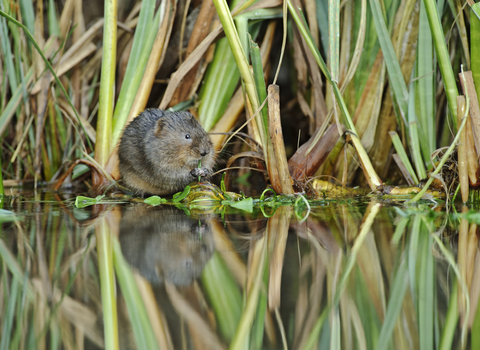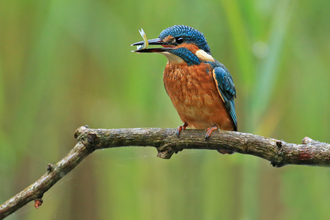Freshwater and wetlands
Water and wetlands are a vital part of our natural world – the lives of animals, plants and people depend on them for their survival. However, freshwater habitats like wetlands, rivers and ponds have been lost, modified and polluted - and the species that depend on them are in decline. Across the UK Wildlife Trusts are working with water companies, government agencies, landowners and other NGOs to improve our freshwater environment for wildlife and people.
Over 10% of our freshwater and wetland species are threatened with extinction in the UK, and we’ve lost 90% of our wetland habitats in the last 100 years.
Why are freshwater habitats important?
Over 10% of our freshwater and wetland species are threatened with extinction in the UK, and we’ve lost 90% of our wetland habitats in the last 100 years. The reasons for this dramatic loss include unsustainable farming and development practices, urbanisation and abstraction. Species are affected by pollution from rural and urban areas, the modification of rivers and wetlands (like adding concrete sides to streams) and the impacts of invasive non-native species, which predate, outcompete and pass disease to our native wetland wildlife.
Thousands of species like otters, kingfishers, salmon, dippers, water voles and herons rely on safe wetland habitat. Healthy wetlands and rivers can also provide communities with protection from flooding by holding water in the landscape and slowing the flow of water through river systems to the sea. They can save us money by naturally filtering the impurities from our water, providing us with cleaner drinking water and reducing the amount of money that water companies need to spend on doing this work.
What do The Wildlife Trusts do?
-
Advise on, support and manage thousands of kilometres of watercourse.
-
Work with natural processes to restore habitats and to hold water in the landscape.
-
Reintroduce wetland species like water voles and beavers.
We have a long history of delivering exciting freshwater and wetlands projects and working closely with partners and empowering communities. The Wildlife Trusts want to see wildlife-rich places that hold water being widespread. Restoring natural processes is a key part of this.
Natural flood management
Storms and flooding have caused significant damage across the UK, and climate change is likely to increase the frequency of extreme weather in the future, costing governments and taxpayers millions and devastating communities and businesses.
The Wildlife Trusts believe that government should invest in wilder landscapes which could provide the natural solutions to help prevent flooding in future. Habitats such as upland bogs and moors, woodlands, wetlands and species-rich grasslands act as giant sponges, absorbing and holding water and slowing down water run-off into rivers.
There are already some excellent examples of how restored landscapes have made space for water, for example, in upland areas where old drainage ditches have been blocked and overgrazing reduced. This allows vegetation like sphagnum mosses and heather and trees to regenerate, helping to hold water in the hills for longer and reducing peak flows downstream during high rainfall events.
We also work on large-scale habitat restoration schemes which slow down water and reconnect rivers with their floodplains. We need these kind of approaches to be significantly extended across the country. This can only happen if investment in flood defence is rebalanced towards these more sustainable solutions.
Improving water quality
We want to see healthy rivers, clean beaches and coastal waters, safe drinking water, less waste and thriving wildlife. We believe that our freshwater environment should be managed as whole systems, from watershed to the sea.
The health of our water bodies like rivers and lakes provides an excellent indicator of the health of the water environment. So it is concerning that only 14% of river water bodies in England currently achieve ‘good ecological status’.
Pollution continues to be the biggest problem facing the freshwater environment. In addition to the pollution pressures from agriculture, around one quarter of rivers are not in good ecological health due to sewage pollution from water companies and private sources like homes and businesses. Soil loss is also negatively impacting on the water quality of local watercourses. Recent estimates by Cranfield University shows soil degradation costing the UK an estimated £1.2bn per year.
As well as the financial cost, our wildlife is at risk from poor water quality as fish spawning grounds are lost to silt building up and feeding becomes harder as visibility is reduced. Too many nutrients in river systems can feed the growth of over-zealous algae and some aquatic plants, which leads to streams and rivers becoming choked up with vegetation and a decrease in plant and wildlife diversity.
This is the aquatic equivalent of our road verges becoming dominated by a handful of plants (like nettles and cow parsley) that thrive in a polluted environment, at the expense of hundreds of others. In our rivers and streams, delicate aquatic plants decrease in number, and the aquatic insects and fish that are adapted to feed on them decline too as a result.
A catchment-based approach
Just as a school catchment describes the area from which children feed into a particular school, a river catchment is the area defined naturally by where the rain water falls, collects and flows through the landscape, forming tributaries, streams and rivers. The boundary of a catchment is formed by high points in the landscape - the 'watershed' - nature doesn't conform to parish boundaries or county borders!
In the past, management of the water environment has fallen to government, to private companies and to landowners, often operating in isolation. The Catchment Based Approach (CaBA) brings people together to think about each river catchment as a whole. More than 1,500 organisations are now taking this approach in over 100 river catchments, covering all of England and Wales.
The Wildlife Trusts are involved in 96% of local CaBA partnerships. This means we can work with many different organisations to develop projects collaboratively, using the different strengths of the individual partners to deliver great quality projects that really make a difference to our precious water environments.
Species conservation and reintroduction
There is an urgent need to restore our wetland habitats to help them to thrive, Species reintroduction are an important part of this and, together with a range of organisations, Wildlife Trusts are leading efforts to reintroduce two key wetland species - water voles and beavers.
The Eurasian beaver (Castor fiber) is a large herbivore, a mammal that was formerly native to these shores and played an important part in our landscape from prehistoric times until it was hunted to extinction in the 16th century for its fur, meat and scent glands. Scottish Wildlife Trust were a partner
Water voles are often referred to as Britain's fastest declining mammal. Unfortunately, the future of this charming riverside creature is in peril; the water vole needs urgent help to survive in the UK. Water voles are a vital part of river ecosystems. Their burrowing, feeding and movements help to create conditions for other animals and plants to thrive - a bit like beavers do, but on a much smaller scale. The Wildlife Trusts and many other organisations are working hard to keep water voles in our rivers and streams and restore them to places where they've been lost.













